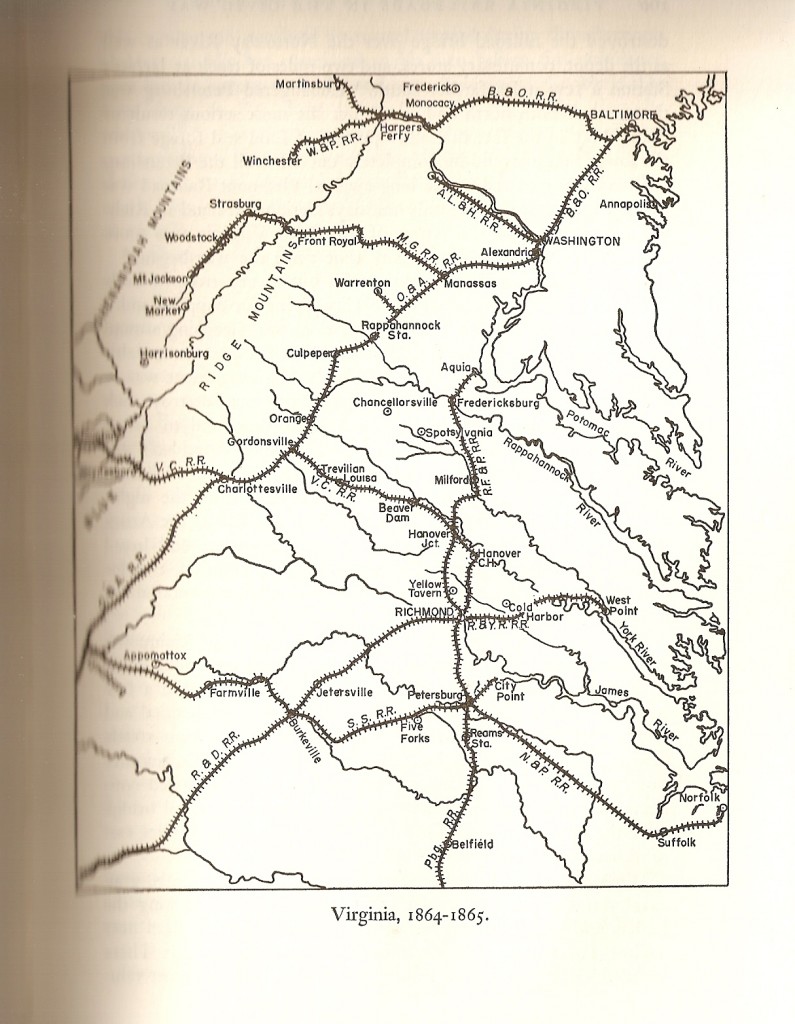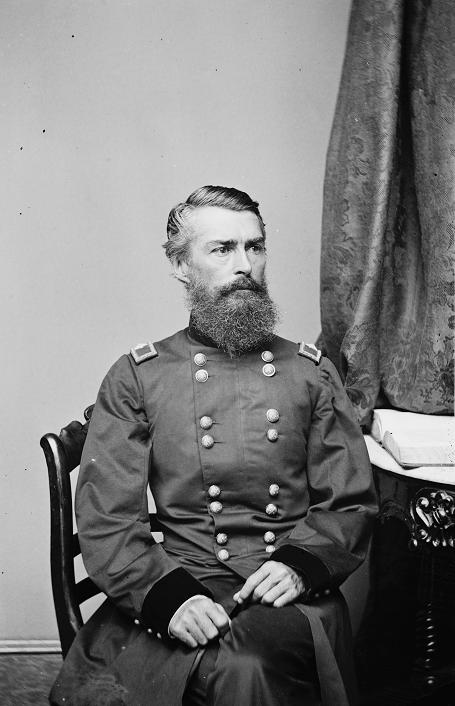Wed 21 Oct 2009
The RF&P Railroad – Material Culture Museum Entry
Posted by sarahlawless under Uncategorized , whitman@umwNo Comments

Note the RF&P railroad on the right side.
When Walt Whitman came down to Fredericksburg in 1862, he traveled along a variety of different transportation methods including trains. Trains were a major factor in American travel before the Civil War and they would become invaluable to the war effort in the North and South. The railroads of Virginia were especially important to the outcome of the war, because of their location in a battleground state. The railway of the Richmond, Fredericksburg, and Potomac company was used by both the Confederate and the Union armies throughout the war. Its destruction and reconstruction was especially pivotal to the battle of Fredericksburg which drew Whitman down to Virginia and D.C.
The Richmond, Fredericksburg, and Potomac railway company was chartered in 1834 and had track laid between Richmond and Fredericksburg by 1837. In 1842, the rail ran all the way to Aquia Creek, where a large wharf was built for the steamboats that provided transportation for the remainder of the journey to and from D.C. This is the state that the RF&P railroad was in when war broke out. In 1862, the Confederates retreated across the Rappahannock to Fredericksburg, abandoning approximately 13 miles of track, the wharves, and three bridges. To prevent the Union troops from using this stretch of railroad, the bridges and wharves were demolished, and the track was destroyed.

Herman Haupt, from a truly enormous wikipedia image
The same year, Herman Haupt, who wasthe commander of the construction corps of the new United States Military Railroad, was charged with rebuilding the railroad up to the Rappahannock for transportation of troops and supplies. With only a few small troops of untrained laborers, handtools, and limited supplies, Haupt rebuilt the wharves, the track and two of the bridges in a matter of weeks. The most impressive piece of this achievement was the bridge across Potomac Creek which needed to be over 400 feet long and 80 feet high and had originally been built by the RF&P co. over the course of a year. Haupt and his men had a bridge up in nine days and trains crossing it a few days after that. The bridge was built in an unconventional fashion using poles cut from the surrounding woods; however, it was sturdy enough for the job. After crossing the the bridge, Lincoln remarked that “upon my word, gentlemen, there is nothing in it but beanpoles and cornstalks” (Griffin 12). In August 1862, the Union army was moving northwards again and General Burnside, not yet commander of the army, ordered the destruction of the bridge. Haupt was understandably upset to see his work destroyed.
"...nothing in it but beanpoles and cornstalks" Abraham Lincoln
In a few months, however, he would have the opportunity to rebuild it. Burnside, now in command of the army, began assembling his men across the Rappahannock by Fredericksburg and once again the wharves, track and bridges had to be rebuilt or repaired to furnish the men with supplies and to offer transportation. This time, the bridge at Potomac Creek was built mainly with prefabricated pieces and remained in place through the battle. Although the railroad was in working order amazingly soon after the repairs began, they still took sometime to complete and this in part contributed to the Confederates’ readiness for the battle when it occurred.

Potomac Creek Bridge, taken on April 18, 1863 by Andrew J. Russell
This would have been the railroad that Whitman rode on to reach his brother in Fredericksburg. He would have ridden by steamboat down from D.C. to Aquia Creek landing and from there, he likely traveled the thirteen miles by train to the banks of the Rappahannock. When he was returning, he would have retraced his steps, although this time in the company of the many sick, wounded, and dying men that were also being transported up to D.C.
Ironically, the same railroad that assisted the Union army at the battle of Fredericksburg was simultaneously assisting the Confederate army. The track still ran south of Fredericksburg to Richmond and was invaluable for transportation of troops, supplies, and information. The trains were so invaluable that Lee ordered that the trains were not to enter Fredericksburg itself, for fear of attack by Union soldiers across the river, but that they should halt at Hamilton’s Crossing about four miles south of Fredericksburg. This was largely due to the increasing scarcity of locomotives and railcars in the south, where proper materials could not be found to repair or build new ones. To further hinder the Union forces in case of Confederate defeat at Fredericksburg, the track between Hamilton’s Crossing and Fredericksburg was torn up just before the battle, truly making the end of the line for the southern section of the RF&P railroad at Hamilton’s Crossing. The battle of Fredericksburg was an unpleasant intimation to Lee of scarcity that he and his men would face in the coming years, not just with locomotives, but with almost any necessity.
In the following winter, the rail services would suffer from undue demands put on them by the military as well as the ordinary citizens of Virginia. Wood especially was scarce, with the demand for firewood in soldier camps as well as in the cities for heat confronting the railroads’ own demands for wood for the boilers and repair of the railroad ties. This was aggravated by theft by undisciplined soldiers or civilians of both the railroad’s firewood and occasionally the railroad ties themselves.
While the southern section of the RF&P railroad remained mostly active for the remainder of the war, despite lack of materials, the section north of the Rappahannock was to be burned and rebuilt one more time, in 1864, when it was used to move wounded soldiers from the battles of the Wilderness and Spotsylvania Court House.
Otherwise, the railroad was used for private use through the war, including an increasingly lucrative contraband business across the Rappahannock. The main items of interest were tobacco and coffee, one lacking in the North, the other lacking in the South. In 1865, Grant decided to end the contraband trade in hopes of hastening the end of the war and captured a train full of tobacco and other supplies heading for Fredericksburg. The contraband was burned. Afterward, a systematic search was made of Fredericksburg houses for more contraband tobacco which was confiscated and burned as well. This ended the contraband trading through Fredericksburg during the war.